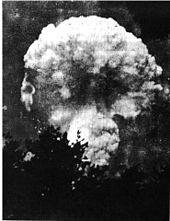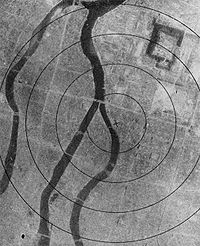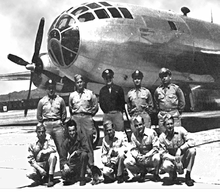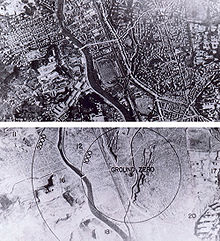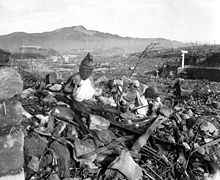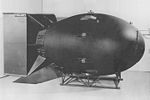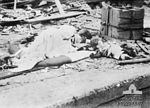- Atomic bombings of Hiroshima and Nagasaki
-
Atomic bombings of Hiroshima and Nagasaki Part of the Pacific War, World War II 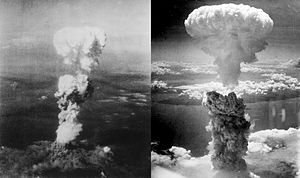
Atomic bomb mushroom clouds over Hiroshima (left) and Nagasaki (right)Date August 6 and 9, 1945 Location Hiroshima and Nagasaki, Japan Result Debated; probably crucial in the surrender of Japan Belligerents  United States
United States Empire of Japan
Empire of JapanUnits involved 509th Composite Group Casualties and losses None 90,000–166,000 killed in Hiroshima[1]
60,000–80,000 killed in Nagasaki[1]Air raids – Mariana Islands – Volcano & Ryukyu Is – Tokyo – Starvation – Naval bombardments – Yokosuka – Sagami Bay – Kure – Downfall – Hiroshima & Nagasaki – Kurils
Japanese surrenderDuring the final stages of World War II in 1945, the United States conducted two atomic bombings against the cities of Hiroshima and Nagasaki in Japan, the first on August 6, 1945, and the second on August 9, 1945. These two events are the only use of nuclear weapons in war to date.[2]
For six months before the atomic bombings, the United States intensely fire-bombed 67 Japanese cities. Together with the United Kingdom and the Republic of China, the United States called for a surrender of Japan in the Potsdam Declaration on July 26, 1945. The Japanese government ignored this ultimatum. By executive order of President Harry S. Truman, the U.S. dropped the nuclear weapon "Little Boy" on the city of Hiroshima on Monday, August 6, 1945,[3][4] followed by the detonation of "Fat Man" over Nagasaki on August 9.
Within the first two to four months of the bombings, the acute effects killed 90,000–166,000 people in Hiroshima and 60,000–80,000 in Nagasaki,[1] with roughly half of the deaths in each city occurring on the first day. The Hiroshima prefectural health department estimates that, of the people who died on the day of the explosion, 60% died from flash or flame burns, 30% from falling debris and 10% from other causes. During the following months, large numbers died from the effect of burns, radiation sickness, and other injuries, compounded by illness. In a U.S. estimate of the total immediate and short term cause of death, 15–20% died from radiation sickness, 20–30% from flash burns, and 50–60% from other injuries, compounded by illness.[5] In both cities, most of the dead were civilians.[6][7][8]
Six days after the detonation over Nagasaki, on August 15, Japan announced its surrender to the Allied Powers, signing the Instrument of Surrender on September 2, officially ending the Pacific War and therefore World War II, as Germany had already signed its Instrument of Surrender on May 7, ending the war in Europe. The bombings led, in part, to post-war Japan's adopting Three Non-Nuclear Principles, forbidding the nation from nuclear armament.[9] The role of the bombings in Japan's surrender and the U.S.'s ethical justification for them, as well as their strategic importance, are still debated.[10][11]
Manhattan Project
Main article: Manhattan ProjectThe secret U.S. project to create the first atomic weapon was known as the Manhattan Project. Working in collaboration with the United Kingdom and Canada, with their respective projects Tube Alloys and Chalk River Laboratories,[12][13] the project designed and built the first atomic bombs. The scientific research was directed by American physicist J. Robert Oppenheimer, and the overall project was under the authority of General Leslie Groves, of the U.S. Army Corps of Engineers. The Hiroshima bomb, a gun-type bomb called "Little Boy", was made with uranium-235, a rare isotope of uranium extracted in giant factories in Oak Ridge, Tennessee. The atomic bomb was first tested at Trinity Site, on July 16, 1945, near Alamogordo, New Mexico. The test weapon, "the gadget", and the Nagasaki bomb, "Fat Man", were both implosion-type devices made primarily of plutonium-239, a synthetic element created in nuclear reactors at Hanford, Washington.[14] Preliminary research began in 1939, originally because of fear that Nazi Germany would develop atomic weapons first. In May 1945, the defeat of Germany caused the focus to turn to possible use against the Japanese.
Choice of targets
 A map showing mission runs of August 6 and August 9, with Hiroshima, Nagasaki, and Kokura (the original target for August 9) displayed.
A map showing mission runs of August 6 and August 9, with Hiroshima, Nagasaki, and Kokura (the original target for August 9) displayed.
On May 10–11, 1945, the Target Committee at Los Alamos, led by J. Robert Oppenheimer, recommended Kyoto, Niigata, Hiroshima, Yokohama, and the arsenal at Kokura as possible targets. The target selection was subject to the following criteria:
- The target was larger than three miles (5 km) in diameter and was an important target in a large urban area.
- The blast would create effective damage.
- The target was unlikely to be attacked by August 1945. "Any small and strictly military objective should be located in a much larger area subject to blast damage in order to avoid undue risks of the weapon being lost due to bad placing of the bomb."[15]
These cities were largely untouched during the nightly bombing raids and the Army Air Force agreed to leave them off the target list so accurate assessment of the weapon could be made. Hiroshima was described as "an important army depot and port of embarkation in the middle of an urban industrial area. It is a good radar target and it is such a size that a large part of the city could be extensively damaged. There are adjacent hills which are likely to produce a focusing effect which would considerably increase the blast damage. Due to rivers it is not a good incendiary target."[15] The goal of the weapon was to convince Japan to surrender unconditionally in accordance with the terms of the Potsdam Declaration. The Target Committee stated that "It was agreed that psychological factors in the target selection were of great importance. Two aspects of this are (1) obtaining the greatest psychological effect against Japan and (2) making the initial use sufficiently spectacular for the importance of the weapon to be internationally recognized when publicity on it is released. Kyoto had the advantage of being an important center for military industry, as well an intellectual center and hence better able to appreciate the significance of the weapon. The Emperor's palace in Tokyo has a greater fame than any other target but is of least strategic value."[15]
During World War II, Edwin O. Reischauer was the Japan expert for the U.S. Army Intelligence Service, in which role he is incorrectly said to have prevented the bombing of Kyoto.[16] In his autobiography, Reischauer specifically refuted the validity of this claim:
- "...the only person deserving credit for saving Kyoto from destruction is Henry L. Stimson, the Secretary of War at the time, who had known and admired Kyoto ever since his honeymoon there several decades earlier."[17]
Potsdam ultimatum
On July 26, Truman and other Allied leaders issued the Potsdam Declaration outlining terms of surrender for Japan. It was presented as an ultimatum and stated that without a surrender, the Allies would attack Japan, resulting in "the inevitable and complete destruction of the Japanese armed forces and just as inevitably the utter devastation of the Japanese homeland". The atomic bomb was not mentioned in the communique. On July 28, Japanese papers reported that the declaration had been rejected by the Japanese government. That afternoon, Prime Minister Kantarō Suzuki declared at a press conference that the Potsdam Declaration was no more than a rehash (yakinaoshi) of the Cairo Declaration and that the government intended to ignore it (mokusatsu, lit. "kill by silence").[18] The statement was taken by both Japanese and foreign papers as a clear rejection of the declaration. Emperor Hirohito, who was waiting for a Soviet reply to noncommittal Japanese peace feelers, made no move to change the government position.[19] On July 31, he made clear to his advisor Kōichi Kido that the Imperial Regalia of Japan had to be defended at all costs.[20]
In early July, on his way to Potsdam, Truman had re-examined the decision to use the bomb. In the end, Truman made the decision to drop the atomic bombs on Japan. His stated intention in ordering the bombings was to bring about a quick resolution of the war by inflicting destruction and instilling fear of further destruction in sufficient strength to cause Japan to surrender.[21]
Hiroshima
Hiroshima during World War II
At the time of its bombing, Hiroshima was a city of some industrial and military significance. A number of military camps were located nearby, including the headquarters of the Fifth Division and Field Marshal Shunroku Hata's 2nd General Army Headquarters, which commanded the defense of all of southern Japan.[22] Hiroshima was a minor supply and logistics base for the Japanese military. The city was a communications center, a storage point, and an assembly area for troops. It was one of several Japanese cities left deliberately untouched by American bombing, allowing a pristine environment to measure the damage caused by the atomic bomb.[23][24]
The center of the city contained several reinforced concrete buildings and lighter structures. Outside the center, the area was congested by a dense collection of small wooden workshops set among Japanese houses. A few larger industrial plants lay near the outskirts of the city. The houses were constructed of wood with tile roofs, and many of the industrial buildings were also built around wood frames. The city as a whole was highly susceptible to fire damage.
The population of Hiroshima had reached a peak of over 381,000 earlier in the war, but prior to the atomic bombing the population had steadily decreased because of a systematic evacuation ordered by the Japanese government. At the time of the attack, the population was approximately 340,000–350,000.[1] Because official documents were burned, the exact population is uncertain.
The bombing
For the composition of the USAAF mission, see 509th Operations Group#Components.Hiroshima was the primary target of the first nuclear bombing mission on August 6, with Kokura and Nagasaki being alternative targets. August 6 was chosen because clouds had previously obscured the target. The 393d Bombardment Squadron B-29 Enola Gay, piloted and commanded by 509th Composite Group commander Colonel Paul Tibbets, was launched from North Field airbase on Tinian in the West Pacific, about six hours flight time from Japan. The Enola Gay (named after Colonel Tibbets' mother) was accompanied by two other B-29s. The Great Artiste, commanded by Major Charles W. Sweeney, carried instrumentation; and a then-nameless aircraft later called Necessary Evil (the photography aircraft) was commanded by Captain George Marquardt.[25]
After leaving Tinian the aircraft made their way separately to Iwo Jima where they rendezvoused at 2,440 meters (8,010 ft) and set course for Japan. The aircraft arrived over the target in clear visibility at 9,855 meters (32,333 ft). During the journey, Navy Captain William Parsons had armed the bomb, which had been left unarmed to minimize the risks during takeoff. His assistant, 2nd Lt. Morris Jeppson, removed the safety devices 30 minutes before reaching the target area.[26]
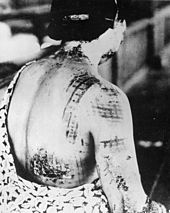 The dark portions of the garments this victim wore during the flash caused burns on the skin.[27]
The dark portions of the garments this victim wore during the flash caused burns on the skin.[27]
About an hour before the bombing, Japanese early warning radar detected the approach of some American aircraft headed for the southern part of Japan. An alert was given and radio broadcasting stopped in many cities, among them Hiroshima. At nearly 08:00, the radar operator in Hiroshima determined that the number of planes coming in was very small—probably not more than three—and the air raid alert was lifted. To conserve fuel and aircraft, the Japanese had decided not to intercept small formations. The normal radio broadcast warning was given to the people that it might be advisable to go to air-raid shelters if B-29s were actually sighted. However a reconnaissance mission was assumed because at 07.31 the first B29 to fly over Hiroshima at 32,000 feet (9,800 m) had been the weather observation aircraft Straight Flush that sent a morse code message to the Enola Gay indicating that the weather was good over the primary target and because it then turned out to sea the 'all clear' was sounded in the city. At 08.09 Colonel Tibbets started his bomb run and handed control over to his bombardier.[28]
The release at 08:15 (Hiroshima time) went as planned, and the gravity bomb known as "Little Boy", a gun-type fission weapon with 60 kilograms (130 lb) of uranium-235, took 43 seconds to fall from the aircraft flying at 31,060 feet (9,470 m)[29] to the predetermined detonation height about 1,900 feet (580 m) above the city. The Enola Gay had traveled 11.5 miles (18.5 km) away before it felt the shock waves from the blast.[30]
Due to crosswind, it missed the aiming point, the Aioi Bridge, by almost 800 feet (240 m) and detonated directly over Shima Surgical Clinic.[31] It created a blast equivalent to about 13 kilotons of TNT (54 TJ). (The U-235 weapon was considered very inefficient, with only 1.38% of its material fissioning.)[32] The radius of total destruction was about one mile (1.6 km), with resulting fires across 4.4 square miles (11 km2).[33] Americans estimated that 4.7 square miles (12 km2) of the city were destroyed. Japanese officials determined that 69% of Hiroshima's buildings were destroyed and another 6–7% damaged.[34]
70,000–80,000 people, or some 30%[35] of the population of Hiroshima were killed immediately, and another 70,000 injured.[36] Over 90% of the doctors and 93% of the nurses in Hiroshima were killed or injured—most had been in the downtown area which received the greatest damage.[37]
Although the U.S. had previously dropped leaflets warning civilians of air raids on 35 Japanese cities, including Hiroshima and Nagasaki,[38] the residents of Hiroshima were given no notice of the atomic bomb.[39][40][41]
Japanese realization of the bombing
The Tokyo control operator of the Broadcasting Corporation of Japan noticed that the Hiroshima station had gone off the air. He tried to re-establish his program by using another telephone line, but it too had failed.[42] About 20 minutes later the Tokyo railroad telegraph center realized that the main line telegraph had stopped working just north of Hiroshima. From some small railway stops within 16 kilometers (10 mi) of the city came unofficial and confused reports of a terrible explosion in Hiroshima. All these reports were transmitted to the headquarters of the Imperial Japanese Army General Staff.
Military bases repeatedly tried to call the Army Control Station in Hiroshima. The complete silence from that city puzzled the men at headquarters; they knew that no large enemy raid had occurred and that no sizeable store of explosives was in Hiroshima at that time. A young officer of the Japanese General Staff was instructed to fly immediately to Hiroshima, to land, survey the damage, and return to Tokyo with reliable information for the staff. It was generally felt at headquarters that nothing serious had taken place and that the explosion was just a rumor.
The staff officer went to the airport and took off for the southwest. After flying for about three hours, while still nearly 100 miles (160 km) from Hiroshima, he and his pilot saw a great cloud of smoke from the bomb. In the bright afternoon, the remains of Hiroshima were burning. Their plane soon reached the city, around which they circled in disbelief. A great scar on the land still burning and covered by a heavy cloud of smoke was all that was left. They landed south of the city, and the staff officer, after reporting to Tokyo, immediately began to organize relief measures.
By August 8, 1945, newspapers in the U.S. were reporting that broadcasts from Radio Tokyo had described the destruction observed in Hiroshima. "Practically all living things, human and animal, were literally seared to death", Japanese radio announcers said in a broadcast received by Allied sources.[43]
Post-attack casualties
Video footage taken in Hiroshima in March 1946 showing victims with severe burns
According to the U.S. Department of Energy the immediate effects of the blast killed approximately 70,000 people in Hiroshima.[44] Estimates of total deaths by the end of 1945 from burns, radiation and related disease, the effects of which were aggravated by lack of medical resources, range from 90,000 to 166,000.[1][45] Some estimates state up to 200,000 had died by 1950, due to cancer and other long-term effects.[3][6][46] Another study states that from 1950 to 2000, 46% of leukemia deaths and 11% of solid cancer deaths among bomb survivors were due to radiation from the bombs, the statistical excess being estimated to 94 leukemia and 848 solid cancers.[47] At least eleven known prisoners of war died from the bombing.[48]
Survival of some structures
Some of the reinforced concrete buildings in Hiroshima had been very strongly constructed because of the earthquake danger in Japan, and their framework did not collapse even though they were fairly close to the blast center. Eizo Nomura (野村 英三 Nomura Eizō) was the closest known survivor, who was in the basement of a reinforced concrete building (it remained as the Rest House after the war) only 170 m (560 ft) from ground zero (the hypocenter) at the time of the attack.[49][50] Akiko Takakura (高蔵 信子 Takakura Akiko) was among the closest survivors to the hypocenter of the blast. She had been in the solidly built Bank of Hiroshima only 300 meters (980 ft) from ground-zero at the time of the attack.[51] Since the bomb detonated in the air, the blast was directed more downward than sideways, which was largely responsible for the survival of the Prefectural Industrial Promotional Hall, now commonly known as the Genbaku, or A-bomb Dome. This building was designed and built by the Czech architect Jan Letzel, and was only 150 m (490 ft) from ground zero. The ruin was named Hiroshima Peace Memorial and was made a UNESCO World Heritage site in 1996 over the objections of the U.S. and China.[52] The Memorial monument for Hiroshima was built in Hiroshima for bombing victims.[53][54][55]
- Gallery
-
A replica of the Little Boy atomic bomb
Events of August 7–9
After the Hiroshima bombing, President Truman issued a statement announcing the use of the new weapon, and promising that:
If they do not now accept our terms, they may expect a rain of ruin from the air, the like of which has never been seen on this earth. Behind this air attack will follow sea and land forces in such numbers and power as they have not yet seen and with the fighting skill of which they are already well aware.[56]
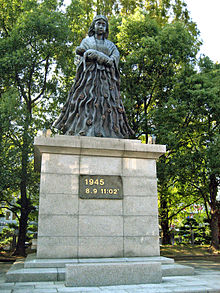 The statue in front of the hypocenter to mark the date and time of the historic bomb explosion in Nagasaki
The statue in front of the hypocenter to mark the date and time of the historic bomb explosion in Nagasaki
The Japanese government still did not react to the Potsdam Declaration. Emperor Hirohito, the government, and the war council were considering four conditions for surrender: the preservation of the kokutai (Imperial institution and national polity), assumption by the Imperial Headquarters of responsibility for disarmament and demobilization, no occupation of the Japanese Home Islands, Korea, or Formosa, and delegation of the punishment of war criminals to the Japanese government.[57]
The Soviet Foreign Minister Vyacheslav Molotov had informed Tokyo of the Soviet Union's unilateral abrogation of the Soviet–Japanese Neutrality Pact on April 5. At two minutes past midnight on August 9, Tokyo time, Soviet infantry, armor, and air forces had launched the Manchurian Strategic Offensive Operation. Four hours later, word reached Tokyo that the Soviet Union had declared war on Japan. The senior leadership of the Japanese Army began preparations to impose martial law on the nation, with the support of Minister of War Korechika Anami, in order to stop anyone attempting to make peace.
Responsibility for the timing of the second bombing was delegated to Colonel Tibbets as commander of the 509th Composite Group on Tinian. Scheduled for August 11 against Kokura, the raid was moved earlier by two days to avoid a five day period of bad weather forecast to begin on August 10.[58] Three bomb pre-assemblies had been transported to Tinian, labeled F-31, F-32, and F-33 on their exteriors. On August 8, a dress rehearsal was conducted off Tinian by Maj. Charles Sweeney using Bockscar as the drop airplane. Assembly F-33 was expended testing the components and F-31 was designated for the August 9 mission.[59]
Nagasaki
I realize the tragic significance of the atomic bomb... It is an awful responsibility which has come to us... We thank God that it has come to us, instead of to our enemies; and we pray that He may guide us to use it in His ways and for His purposes.
—President Harry S. Truman, August 9, 1945[60]
Nagasaki during World War II
The city of Nagasaki had been one of the largest sea ports in southern Japan and was of great wartime importance because of its wide-ranging industrial activity, including the production of ordnance, ships, military equipment, and other war materials.
In contrast to many modern aspects of Hiroshima, almost all of the buildings were of old-fashioned Japanese construction, consisting of wood or wood-frame buildings with wood walls (with or without plaster) and tile roofs. Many of the smaller industries and business establishments were also situated in buildings of wood or other materials not designed to withstand explosions. Nagasaki had been permitted to grow for many years without conforming to any definite city zoning plan; residences were erected adjacent to factory buildings and to each other almost as closely as possible throughout the entire industrial valley.
Nagasaki had never been subjected to large-scale bombing prior to the explosion of a nuclear weapon there. On August 1, 1945, however, a number of conventional high-explosive bombs were dropped on the city. A few hit in the shipyards and dock areas in the southwest portion of the city, several hit the Mitsubishi Steel and Arms Works, and six bombs landed at the Nagasaki Medical School and Hospital, with three direct hits on buildings there. While the damage from these bombs was relatively small, it created considerable concern in Nagasaki and many people—principally school children—were evacuated to rural areas for safety, thus reducing the population in the city at the time of the nuclear attack.
To the north of Nagasaki there was a camp holding British Commonwealth prisoners of war, some of whom were working in the coal mines and only found out about the bombing when they came to the surface.
The bombing
For the composition of the USAAF mission, see 509th Operations Group#Components.On the morning of August 9, 1945, the U.S. B-29 Superfortress Bockscar, flown by the crew of 393rd Squadron commander Major Charles W. Sweeney, carried the nuclear bomb code-named "Fat Man", with Kokura as the primary target and Nagasaki the secondary target. The mission plan for the second attack was nearly identical to that of the Hiroshima mission, with two B-29s flying an hour ahead as weather scouts and two additional B-29s in Sweeney's flight for instrumentation and photographic support of the mission. Sweeney took off with his weapon already armed but with the electrical safety plugs still engaged.[61]
Observers aboard the weather planes reported both targets clear. When Sweeney's aircraft arrived at the assembly point for his flight off the coast of Japan, the third plane, Big Stink, flown by the group's Operations Officer, Lt. Col. James I. Hopkins, Jr. failed to make the rendezvous. Bockscar and the instrumentation plane circled for 40 minutes without locating Hopkins. Already 30 minutes behind schedule, Sweeney decided to fly on without Hopkins.[61]
By the time they reached Kokura a half hour later, a 70% cloud cover had obscured the city, prohibiting the visual attack required by orders. After three runs over the city, and with fuel running low because a transfer pump on a reserve tank had failed before take-off, they headed for their secondary target, Nagasaki.[61] Fuel consumption calculations made en route indicated that Bockscar had insufficient fuel to reach Iwo Jima and would be forced to divert to Okinawa. After initially deciding that if Nagasaki were obscured on their arrival the crew would carry the bomb to Okinawa and dispose of it in the ocean if necessary, the weaponeer Navy Commander Frederick Ashworth decided that a radar approach would be used if the target was obscured.[62]
At about 07:50 Japanese time, an air raid alert was sounded in Nagasaki, but the "all clear" signal was given at 08:30. When only two B-29 Superfortresses were sighted at 10:53, the Japanese apparently assumed that the planes were only on reconnaissance and no further alarm was given.
A few minutes later at 11:00, The Great Artiste, the support B-29 flown by Captain Frederick C. Bock, dropped instruments attached to three parachutes. These instruments also contained an unsigned letter to Professor Ryokichi Sagane, a nuclear physicist at the University of Tokyo who studied with three of the scientists responsible for the atomic bomb at the University of California, Berkeley, urging him to tell the public about the danger involved with these weapons of mass destruction. The messages were found by military authorities but not turned over to Sagane until a month later.[63] In 1949, one of the authors of the letter, Luis Alvarez, met with Sagane and signed the document.[64]
At 11:01, a last minute break in the clouds over Nagasaki allowed Bockscar's bombardier, Captain Kermit Beahan, to visually sight the target as ordered. The "Fat Man" weapon, containing a core of ~6.4 kg (14.1 lbs.) of plutonium-239, was dropped over the city's industrial valley. It exploded 43 seconds later at 469 meters (1,540 ft) above the ground exactly halfway between the Mitsubishi Steel and Arms Works in the south and the Mitsubishi-Urakami Ordnance Works (Torpedo Works) in the north. This was nearly 3 kilometers (2 mi) northwest of the planned hypocenter; the blast was confined to the Urakami Valley and a major portion of the city was protected by the intervening hills.[65] The resulting explosion had a blast yield equivalent to 21 kilotons of TNT (88 TJ).[66] The explosion generated heat estimated at 3,900 degrees Celsius (4,200 K, 7,000 °F) and winds that were estimated at 1005 km/h (624 mph).
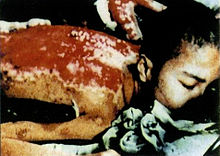 A photograph of Sumiteru Taniguchi's back injuries taken in January 1946 by a U.S. Marine photographer.
A photograph of Sumiteru Taniguchi's back injuries taken in January 1946 by a U.S. Marine photographer.
Casualty estimates for immediate deaths range from 40,000 to 75,000.[67][68][69] Total deaths by the end of 1945 may have reached 80,000.[1] At least eight known POWs died from the bombing and as many as 13 POWs may have died:
- One British Commonwealth citizen[70][71][72][73][74] died in the bombing.
- Seven Dutch POWs (two names known)[75] died in the bombing.
- At least two POWs reportedly died postwar from cancer thought to have been caused by the atomic bomb.[76][77]
The radius of total destruction was about a mile (1–2 km), followed by fires across the northern portion of the city to two miles (3 km) south of the bomb.[78][79]
One American POW, Joe Kieyoomia, was in Nagasaki at the time of the bombing but survived, reportedly having been shielded from the effects of the bomb by the concrete walls of his cell.[80]
An unknown number of survivors from the Hiroshima bombing had made their way to Nagasaki, where they were bombed again.[81][82]
The Mitsubishi-Urakami Ordnance Works, the factory that manufactured the type 91 torpedoes released in Pearl Harbor, was destroyed in the blast.[83]
There is also a peace monument and Bell of Nagasaki in the Kokura.[84]
- Gallery
Plans for more atomic attacks on Japan
The U.S. expected to have another atomic bomb ready for use in the third week of August, with three more in September and a further three in October.[85] On August 10, Major General Leslie Groves, military director of the Manhattan Project, sent a memorandum to General of the Army George Marshall, Army Chief of Staff, in which he wrote that "the next bomb . . should be ready for delivery on the first suitable weather after 17 or August 18." On the same day, Marshall endorsed the memo with the comment, "It is not to be released over Japan without express authority from the President."[85] There was already discussion in the War Department about conserving the bombs in production until Operation Downfall, the projected invasion of Japan, had begun. "The problem now [August 13] is whether or not, assuming the Japanese do not capitulate, to continue dropping them every time one is made and shipped out there or whether to hold them . . . and then pour them all on in a reasonably short time. Not all in one day, but over a short period. And that also takes into consideration the target that we are after. In other words, should we not concentrate on targets that will be of the greatest assistance to an invasion rather than industry, morale, psychology, and the like? Nearer the tactical use rather than other use."[85]
Tibbets, in an interview with historian Studs Terkel, stated that because there was silence from Japan following both the first and second atomic bombing, he was ordered by General Curtis LeMay back to Utah from Tinian to pick up another atomic bomb. But when his crew got to California, the debarkation point, the war was over.[86]
Surrender of Japan and subsequent occupation
Main articles: Surrender of Japan and Occupation of JapanUntil August 9, the war council had still insisted on its four conditions for surrender. On that day Hirohito ordered Kido to "quickly control the situation ... because the Soviet Union has declared war against us." He then held an Imperial conference during which he authorized minister Tōgō to notify the Allies that Japan would accept their terms on one condition, that the declaration "does not compromise any demand which prejudices the prerogatives of His Majesty as a Sovereign ruler."[87]
On August 10, the Japanese government presented a letter of protest for the atomic bombings to the government of the United States via the government of Switzerland.[88] On August 12, the Emperor informed the imperial family of his decision to surrender. One of his uncles, Prince Asaka, then asked whether the war would be continued if the kokutai could not be preserved. Hirohito simply replied "of course."[89] As the Allied terms seemed to leave intact the principle of the preservation of the Throne, Hirohito recorded on August 14 his capitulation announcement which was broadcast to the Japanese nation the next day despite a short rebellion by militarists opposed to the surrender.
In his declaration, Hirohito referred to the atomic bombings:
Moreover, the enemy now possesses a new and terrible weapon with the power to destroy many innocent lives and do incalculable damage. Should we continue to fight, not only would it result in an ultimate collapse and obliteration of the Japanese nation, but also it would lead to the total extinction of human civilization. Such being the case, how are We to save the millions of Our subjects, or to atone Ourselves before the hallowed spirits of Our Imperial Ancestors? This is the reason why We have ordered the acceptance of the provisions of the Joint Declaration of the Powers.In his "Rescript to the soldiers and sailors" delivered on August 17, he stressed the impact of the Soviet invasion and his decision to surrender, omitting any mention of the bombs.
During the year after the bombing, approximately 40,000 U.S. troops occupied Hiroshima, while Nagasaki was occupied by 27,000 troops.
Depiction, public response and censorship
 Anti-Japanese propaganda poster depicting the Bataan Death March, 1944, US
Anti-Japanese propaganda poster depicting the Bataan Death March, 1944, US
During the war "annihilationist and exterminationalist rhetoric" was tolerated at all levels of U.S. society; according to the UK embassy in Washington the Americans regarded the Japanese as "a nameless mass of vermin".[90] Caricatures depicting Japanese as less than human, e.g. monkeys, were common.[90] A 1944 opinion poll that asked what should be done with Japan found that 13% of the U.S. public were in favor of the extermination of all Japanese: men, women, and children.[91][92]
Life among the rubble in Hiroshima in March and April 1946. Film footage taken by Lieutenant Daniel A. McGovern (director) and Harry Mimura (cameraman) for a United States Strategic Bombing Survey project. The Hiroshima ruins in March and April 1946, by Daniel A. McGovern and Harry Mimura
The Hiroshima ruins in March and April 1946, by Daniel A. McGovern and Harry Mimura
News of the atomic bombing was greeted enthusiastically in the U.S.; a poll in Fortune magazine in late 1945 showed a significant minority of Americans wishing that more atomic bombs could have been dropped on Japan.[93] The initial positive response was supported by the imagery presented to the public (mainly the powerful mushroom cloud) and the censorship of photographs that showed corpses incinerated by the blast as well as photos of maimed survivors.[93] As an example, a member of the U.S. Strategic Bombing Survey, Lieutenant Daniel McGovern, used a film crew to document the results. The film crew's work resulted in a three-hour documentary entitled The Effects of the Atomic Bombs Against Hiroshima and Nagasaki. The documentary included images from hospitals showing the human effects of the bomb; it showed burned out buildings and cars, and rows of skulls and bones on the ground. When sent to the U.S., it was mentioned widely in the U.S. press, then quietly suppressed and never shown. It was classified "top secret" for the next 22 years.[94] During this time in America, it was a common practice for editors to keep graphic images of death out of films, magazines, and newspapers.[95][96] The total of 90,000 ft. of footage filmed by Lieutenant Daniel McGovern's cameramen had not been fully aired as of 2009. However, according to Greg Mitchell, with the 2004 documentary film Original Child Bomb, a small part of that footage managed to reach part of the American public "in the unflinching and powerful form its creators intended".[97]
Imagery of the atomic bombings was suppressed in Japan during the occupation[98] although some Japanese magazines had managed to publish images before the Allied occupation troops took control. The Allied occupation forces enforced censorship on anything "that might, directly or by inference, disturb public tranquility", and pictures of the effects on people on the ground were deemed inflammatory. A likely reason for the banning was that the images depicting burn victims and funeral pyres evoked similarities to the widely circulated images taken in liberated Nazi concentration camps.[99]
Motion picture company Nippon Eigasha started sending cameramen to Nagasaki and Hiroshima in September 1945. On 24 October 1945 a US military policeman stopped a Nippon Eigasha cameraman from continuing to film in Nagasaki. All Nippon Eigasha's reels were then confiscated by the American authorities. In turn requested by the Japanese government, declassified and saved from oblivion, some black-and-white motion pictures were released for the first time to the Japanese and American audiences in the years from 1968 to 1970.[97]
Atomic Bomb Casualty Commission
In the spring of 1948, the Atomic Bomb Casualty Commission (ABCC) was established in accordance with a presidential directive from Harry S. Truman to the National Academy of Sciences–National Research Council to conduct investigations of the late effects of radiation among the survivors in Hiroshima and Nagasaki.
Among the casualties were found many unintended victims, including Allied POWs,[100] Korean and Chinese laborers, students from Malaya on scholarships, and some 3,200 Japanese American citizens.[101]
One of the early studies conducted by the ABCC was on the outcome of pregnancies occurring in Hiroshima and Nagasaki, and in a control city, Kure located 18 miles (29 km) south from Hiroshima, in order to discern the conditions and outcomes related to radiation exposure. One author has claimed that the ABCC refused to provide medical treatment to the survivors for better research results.[102] In 1975, the Radiation Effects Research Foundation was created to assume the responsibilities of ABCC.[103]
Hibakusha
Main article: HibakushaThe survivors of the bombings are called hibakusha (被爆者), a Japanese word that literally translates to "explosion-affected people." As of March 31, 2011[update], 219,410 surviving hibakusha were recognized by the Japanese government, most living in Japan.[104] The government of Japan recognizes about 1% of these as having illnesses caused by radiation.[105] The memorials in Hiroshima and Nagasaki contain lists of the names of the hibakusha who are known to have died since the bombings. Updated annually on the anniversaries of the bombings, as of August 2011[update] the memorials record the names of more than 430,000 deceased hibakusha; 275,230 in Hiroshima[106] and 155,546 in Nagasaki.[107]
Double survivors
People who suffered the effects of both bombings are known as nijū hibakusha in Japan. On March 24, 2009, the Japanese government officially recognized Tsutomu Yamaguchi (1916–2010) as a double hibakusha. He was confirmed to be 3 kilometers from ground zero in Hiroshima on a business trip when Little Boy was detonated. He was seriously burnt on his left side and spent the night in Hiroshima. He arrived at his home city of Nagasaki on August 8, a day before Fat Man was dropped, and he was exposed to residual radiation while searching for his relatives. He was the first officially recognised survivor of both bombings.[108] Tsutomu Yamaguchi died on January 4, 2010, after a battle with stomach cancer at the age of 93.[109] The 2006 documentary Twice Survived: The Doubly Atomic Bombed of Hiroshima and Nagasaki documented 165 nijū hibakusha, and was screened at the United Nations.[110]
Korean survivors
During the war, Japan brought many Korean conscripts to both Hiroshima and Nagasaki to work as forced labor.[111] According to recent estimates, about 20,000 Koreans were killed in Hiroshima and about 2,000 died in Nagasaki. It is estimated that one in seven of the Hiroshima victims was of Korean ancestry.[7] A Korean prince of the Joseon Dynasty, Yi Wu, also died from the Hiroshima bombing.[112] For many years, Koreans had a difficult time fighting for recognition as atomic bomb victims and were denied health benefits. However, most issues have been addressed in recent years through lawsuits.[113]
Debate over bombings
Further information: Operation Downfall“ The atomic bomb was more than a weapon of terrible destruction; it was a psychological weapon. ” —Former U.S. Secretary of War Henry L. Stimson, 1947[114]
The role of the bombings in Japan's surrender and the U.S.'s ethical justification for them has been the subject of scholarly and popular debate for decades. J. Samuel Walker wrote in an April 2005 overview of recent historiography on the issue, "the controversy over the use of the bomb seems certain to continue." Walker wrote that "The fundamental issue that has divided scholars over a period of nearly four decades is whether the use of the bomb was necessary to achieve victory in the war in the Pacific on terms satisfactory to the United States."[10]
Supporters of the bombings generally assert that they caused the Japanese surrender, preventing massive casualties on both sides in the planned invasion of Japan: Kyūshū was to be invaded in October 1945 and Honshū five months later. U.S. Secretary of War Henry L. Stimson estimated the invading Allies would suffer between 1.7 and 4 million casualties in such a scenario, while Japanese casualties would have been up to 10 million.[115] Although thousands of Japanese were taken prisoner,[116] most fought until they were killed or committed suicide.[117] According to Risa Brooks and Elizabeth A. Stanley, "One scholar estimated that kamikaze attacks could have sunk or damaged a full third of the invasion armada destined for Kyūshū."[116] As the chief commander of the Japanese army, Korechika Anami was outspoken against the idea of surrender. Even after the bombings of Hiroshima and Nagasaki, Anami opposed talk of surrender, and proposed instead that a large-scale battle be fought on the Japanese mainland causing such massive Allied casualties that Japan would somehow be able to evade surrender and perhaps even keep some of what it had conquered.[118] There were 2.3 million Japanese Army troops prepared to defend the Japanese home islands, another 4 million Army and Navy employees, and a civilian militia of 28 million men and women.[119] The national slogan was “One hundred million will die for the Emperor and Nation.”[120] The Japanese military ordered the murder of all Allied prisoners if there was an invasion.[120] Eventually, Anami's arguments were overcome when Emperor Hirohito directly requested an end to the war himself.[121]
Those who oppose the bombings, among them many US military leaders as well as ex-president Herbert Hoover, argue that it was simply an extension of the already fierce conventional bombing campaign.[122] This, together with the sea blockade and the collapse of Germany (with its implications regarding redeployment), would also have led to a Japanese surrender - so the atomic bombings were militarily unnecessary.[11] On the contrary, according to Kyoko Iriye Selden, "The most influential text is Truman's 1955 Memoirs, which states that the atomic bomb probably saved half a million US lives— anticipated casualties in an Allied invasion of Japan planned for November. Stimson subsequently talked of saving one million US casualties, and Churchill of saving one million American and half that number of British lives."[123]
Scholars have pointed out various alternatives that could have ended the war just as quickly without an invasion, but these alternatives could have resulted in the deaths of many more Japanese.[124]
As the United States dropped its atomic bombs on Hiroshima and Nagasaki in August 1945, 1.6 million Soviet troops launched a surprise attack on the Japanese forces occupying eastern Asia. "The Soviet entry into the war played a much greater role than the atomic bombs in inducing Japan to surrender because it dashed any hope that Japan could terminate the war through Moscow's mediation", said Japanese historian Tsuyoshi Hasegawa, whose recently published Racing the Enemy: Stalin, Truman, and the Surrender of Japan is based on recently declassified Soviet archives as well as U.S. and Japanese documents.[125]
Legal situation in Japan
Main article: Ryuichi Shimoda v. The StateThe Tokyo District Court, while denying a case for damages, stated: [126]
... (b) that the dropping of atomic bombs as an act of hostilities was illegal under the rules of positive international law (taking both treaty law and customary law into consideration) then in force... (c) that the dropping of atomic bombs also constituted a wrongful act on the plane of municipal law, ascribable to the United States and its President, Mr. Harry S. Truman; ...The aerial bombardment with atomic bombs of the cities of Hiroshima and Nagasaki was an illegal act of hostilities according to the rules of international law. It must be regarded as indiscriminate aerial bombardment of undefended cities, even if it were directed at military objectives only, inasmuch as it resulted in damage comparable to that caused by indiscriminate bombardment.See also
- Anti-nuclear protests in the United States
- Hiroshima Maidens
- Hiroshima National Peace Memorial Hall for the Atomic Bomb Victims
- Japan and weapons of mass destruction
- Japanese nuclear weapon program
- Nagasaki Atomic Bomb Museum
- Nagasaki Peace Park
- Nuclear weapons and the United States
- Pumpkin bomb, dummy atomic bomb
- Strategic bombing during World War II
References
- ^ a b c d e f "Frequently Asked Questions #1". Radiation Effects Research Foundation. http://www.rerf.or.jp/general/qa_e/qa1.html. Retrieved September 18, 2007.
- ^ Hakim, Joy (1995). A History of Us: War, Peace and all that Jazz. New York: Oxford University Press. ISBN 0-19-509514-6.
- ^ a b Rezelman, David; F.G. Gosling and Terrence R. Fehner (2000). "The atomic bombing of hiroshima". The Manhattan Project: An Interactive History. U.S. Department of Energy. http://www.cfo.doe.gov/me70/manhattan/hiroshima.htm. Retrieved September 18, 2007.[dead link] page on Hiroshima casualties.
- ^ Adams, S. & Crawford, A.. 2000. World War II. First edition. Printed in association with the Imperial War Museum. Eyewitness Books series. New York, Doring Kindersley Limited.
- ^ Harry S. Truman Library & Museum. U. S. Strategic Bombing Survey: The Effects of the Atomic Bombings of Hiroshima and Nagasaki, June 19, 1946. President's Secretary's File, Truman Papers. 2. Hiroshima., page 22 of 51.
- ^ a b The Spirit of Hiroshima: An Introduction to the Atomic Bomb Tragedy. Hiroshima Peace Memorial Museum. 1999.
- ^ a b Mikiso Hane (2001). Modern Japan: A Historical Survey. Westview Press. ISBN 0-8133-3756-9.
- ^ Trinity and Beyond: The atomic bomb movie. Dir. Kuran, P., Nar. Shatner, W.. 1997. VHS. Goldhil Video, 1997.
- ^ Koizumi, Junichiro (August 6, 2005). "Address by Prime Minister Junichiro Koizumi at the Hiroshima Memorial Service for the Hiroshima Peace Memorial Ceremony". Prime Minister of Japan and His Cabinet. http://www.kantei.go.jp/foreign/koizumispeech/2005/08/06aisatu_e.html. Retrieved Nov. 28, 2007.
- ^ a b Walker, J. Samuel (April 2005). "Recent Literature on Truman's Atomic Bomb Decision: A Search for Middle Ground". Diplomatic History 29 (2): 334. doi:10.1111/j.1467-7709.2005.00476.x.
- ^ a b The Collins Encyclopedia of Military History, Dupuy & Dupuy, BCA 1994, page 1308
- ^ Roosevelt, Frankin D; Churchill, Winston (August 19, 1943). "Quebec Agreement". atomicarchive.com. http://www.atomicarchive.com/Docs/ManhattanProject/Quebec.shtml.
- ^ Edwards, Gordon. "Canada's Role in the Atomic Bomb Programs of the United States, Britain, France and India". Canadian Coalition for Nuclear Responsibility. http://www.ccnr.org/chronology.html. Retrieved Dec. 4, 2007.
- ^ Gosling, F.G. (January 1999). "The Manhattan Project: Making the Atomic Bomb" (PDF). United States Department of Energy. http://www.cfo.doe.gov/me70/manhattan/publications/DE99001330.pdf. Retrieved Dec. 4, 2007.[dead link]
- ^ a b c "Atomic Bomb: Decision—Target Committee, May 10–11, 1945". http://www.dannen.com/decision/targets.html. Retrieved August 6, 2005.
- ^ "A-bomb targets/decision-making record (1945)". Dannen.com. http://www.dannen.com/decision/targets.html. Retrieved Mar. 25, 2009.
- ^ Reischauer, Edwin. (1986). My Life Between Japan And America, p. 101.
- ^ Frank, Richard B. Downfall. pp. 233–234. ISBN 0141001461. The meaning of the word mokusatsu can fall anywhere in the range of "ignore" to "treat with contempt".
- ^ Bix, Herbert (1996). "Japan's Delayed Surrender: A Reinterpretation". In Michael J. Hogan, ed. Hiroshima in History and Memory. Cambridge University Press. p. 290. ISBN 0-521-56682-7.
- ^ Kido Koichi nikki, Tokyo, Daigaku Shuppankai, 1966, p.1120–1121
- ^ Allen, Thomas; Norman Polmar (1995). Code-Name Downfall. New York: Simon & Schuster. pp. 266–270. ISBN 0684804069.
- ^ "World War 2". World-war-2.info. http://www.world-war-2.info/atomic-bomb/. Retrieved November 4, 2010.
- ^ Goldstein, Donald (1999). Rain of Ruin. Washington: Potomac Books. p. 41. ISBN 9781574882216
- ^ Hastings, Max (2008). Nemesis: The Battle for Japan, 1944-45. HarperCollins. p. 509. ISBN 9780007219810
- ^ "Timeline #2- the 509th; The Hiroshima Mission". Children of the Manhattan Project. Archived from the original on Oct. 9, 2006. http://web.archive.org/web/20061009095411/http://www.childrenofthemanhattanproject.org/CG/CG_09C1.htm. Retrieved July 26, 2006.
- ^ "Timeline #2- the 509th; The Hiroshima Mission". The Atomic Heritage Foundation. http://www.mphpa.org/classic/HISTORY/H-07L1.htm. Retrieved May 5, 2007.
- ^ "Radiation Event Medical Management. Thermal Skin Burns: Example after Nuclear Blast". Remm.nlm.gov. http://www.remm.nlm.gov/flashburn2.htm. Retrieved Mar. 25, 2009.
- ^ Louis Allen (1969). The Nuclear Raids Article - History of the Second World War. Purnell.
- ^ John L.Pimlot(Consultant editor) (1989). The Apocalypse Bomb - The World at Arms. Readers Digest.
- ^ "The Atomic Bombing of Hiroshima, Aug 6, 1945". www.cfo.doe.gov. http://www.cfo.doe.gov/me70/manhattan/hiroshima.htm. Retrieved Jun. 25, 2010.[dead link]
- ^ Enola Gay, ISBN 0-671-81499-0, page 309
- ^ "The Bomb-"Little Boy"". The Atomic Heritage Foundation. http://www.mphpa.org/classic/HISTORY/little_boy.htm. Retrieved May 5, 2007.
- ^ "RADIATION DOSE RECONSTRUCTION U.S. OCCUPATION FORCES IN HIROSHIMA AND NAGASAKI, JAPAN, 1945-1946 (DNA 5512F)" (PDF). Archived from the original on Jun. 24, 2006. http://web.archive.org/web/20060624185903/http://www.dtra.mil/toolbox/directorates/td/programs/nuclear_personnel/docs/DNATR805512F.pdf. Retrieved June 9, 2006.
- ^ Harry S. Truman Library & Museum. U. S. Strategic Bombing Survey: The Effects of the Atomic Bombings of Hiroshima and Nagasaki, June 19, 1946. President's Secretary's File, Truman Papers. 2. Hiroshima., page 14 of 51. Retrieved on March 15, 2009.
- ^ Harry S. Truman Library & Museum. U. S. Strategic Bombing Survey: The Effects of the Atomic Bombings of Hiroshima and Nagasaki, June 19, 1946. President's Secretary's File, Truman Papers. 2. Hiroshima., page 11 of 51. Retrieved on March 15, 2009.
- ^ Harry S. Truman Library & Museum. U. S. Strategic Bombing Survey: The Effects of the Atomic Bombings of Hiroshima and Nagasaki, June 19, 1946. President's Secretary's File, Truman Papers. Effort and Results., page 42 of 51. Retrieved on March 15, 2009.
- ^ Harry S. Truman Library & Museum. U. S. Strategic Bombing Survey: The Effects of the Atomic Bombings of Hiroshima and Nagasaki, June 19, 1946. President's Secretary's File, Truman Papers. 2. Hiroshima., page 12 of 51. Retrieved on March 15, 2009.
- ^ "The Information War in the Pacific, 1945". https://www.cia.gov/library/center-for-the-study-of-intelligence/csi-publications/csi-studies/studies/vol46no3/article07.html.
- ^ "Decision to Drop Atomic Bomb". Cia.gov. http://www.atomicmuseum.com/tour/decision.cfm. Retrieved Mar. 25, 2009.
- ^ "The Myths of Hiroshima". Commondreams.org. http://www.commondreams.org/views05/0805-24.htm. Retrieved Mar. 25, 2009.
- ^ "Hiroshima: Historians' Letter to the Smithsonian". Doug-long.com. http://www.doug-long.com/letter.htm. Retrieved Mar. 25, 2009.
- ^ "No High Ground by Knebel et al. p175 to p201" (PDF). http://www.uncp.edu/home/berrys/courses/hist102/hist102_docs_abomb.pdf. Retrieved April 30, 2007.
- ^ "Fulton Sun Retrospective". http://www.fultonsun.com/articles/2005/08/07/news/146news11.txt. Retrieved July 8, 2007.[dead link]
- ^ U.S. Department of Energy. Office of History & Heritage Resources. The Manhattan Project: An Interactive History. The Atomic Bombing of Hiroshima, August 6, 1945.[dead link] Retrieved on January 8, 2010.
- ^ "Chapter II: The Effects of the Atomic Bombings". United States Strategic Bombing Survey. Originally by U.S. G.P.O.; stored on ibiblio.org. 1946. http://www.ibiblio.org/hyperwar/AAF/USSBS/AtomicEffects/AtomicEffects-2.html. Retrieved September 18, 2007.
- ^ Another review and analysis of the various death toll estimates is in: Richard B. Frank (2001). Downfall: The End of the Imperial Japanese Empire. Penguin Publishing. ISBN 0-679-41424-X.
- ^ "Frequently Asked Questions #2". Radiation Effects Research Foundation. http://www.rerf.or.jp/general/qa_e/qa2.html.
- ^ "David Rubin, 2005, "Remembering Normand Brissette" (Downloaded 28/10/06)". Wagingpeace.org. http://www.wagingpeace.org/articles/2005/08/20_rubin_remembering-normand-brissette.htm. Retrieved Mar. 25, 2009.
- ^ "Special Exhibit 3". Hiroshima Peace Memorial Museum. http://www.pcf.city.hiroshima.jp/virtual/VirtualMuseum_e/exhibit_e/exh0203_e/exh02033_e.html. Retrieved August 30, 2010.
- ^ Kato, Toru (June 4, 1999). "A Short-Sighted Parrot". Geocities.jp. http://www.geocities.jp/cato1963/kinganE.html. Retrieved March 25, 2009.
- ^ "Testimony of Akiko Takakura". http://www.inicom.com/hibakusha/akiko.html. Retrieved April 30, 2007.
- ^ "unesco.org". http://whc.unesco.org/archive/repco96x.htm#annex5. Retrieved August 6, 2005.
- ^ "(原爆死没者慰霊碑)碑文趣旨・説明板". Yutaka901.fc2web.com. http://yutaka901.fc2web.com/page2ax2g.html. Retrieved November 4, 2010.
- ^ "原爆慰霊碑碑文論争". Homepage.mac.com. http://homepage.mac.com/misaon1/hamayuu/hibunronso.html. Retrieved November 4, 2010.
- ^ 原爆碑損壊事件声明文
- ^ Statement by the President Announcing the Use of the A-Bomb at Hiroshima (August 6, 1945).
- ^ H. Bix, Hirohito and the Making of Modern Japan, 2001, p. 512.
- ^ Martin J. Sherwin (2003). A World Destroyed: Hiroshima and its Legacies (2nd ed.). Stanford University Press. pp. 233–234. ISBN 0804739579.
- ^ Richard H. Campbell (2005). "Chapter 2: Development and Production". The Silverplate Bombers: A History and Registry of the Enola Gay and Other B-29s Configured to Carry Atomic Bombs. McFarland & Company, Inc.. p. 114. ISBN 0-7864-2139-8.
- ^ Radio Report to the American People on the Potsdam Conference by President Harry S. Truman, Delivered from the White House at 10 p.m, August 9, 1945
- ^ a b c "Timeline #3- the 509th; The Nagasaki Mission". The Atomic Heritage Foundation. http://www.mphpa.org/classic/HISTORY/H-07m1.htm. Retrieved May 5, 2007.
- ^ "Spitzer Personal Diary Page 25 (CGP-ASPI-025)". The Atomic Heritage Foundation. http://www.mphpa.org/classic/COLLECTIONS/CG-ASPI/01/Pages/CGP-ASPI-025.htm. Retrieved May 5, 2007.
- ^ Lillian Hoddeson, et al., Critical Assembly: A Technical History of Los Alamos During the Oppenheimer Years, 1943-1945 (New York: Cambridge University Press, 1993), on 295.
- ^ "Stories from Riken" (PDF). http://www.riken.jp/r-world/info/release/riken88/text/image/pdf/no09e.pdf. Retrieved April 30, 2007.
- ^ Dennis D. Wainstock (1996). The Decision to Drop the Atomic Bomb. Praeger. p. 92. ISBN 0275954757.
- ^ "The Atomic Bomb". Pbs.org. http://www.pbs.org/thewar/detail_5234.htm. Retrieved November 4, 2010.
- ^ Rinjiro Sodei. Were We the Enemy?: American Survivors of Hiroshima. Boulder: Westview Press, 1998, ix.
- ^ Rezelman, David; F.G. Gosling and Terrence R. Fehner (2000). "The atomic bombing of nagasaki". The Manhattan Project: An Interactive History. U.S. Department of Energy. http://www.cfo.doe.gov/me70/manhattan/nagasaki.htm. Retrieved September 18, 2007.[dead link]
- ^ "Nagasaki's Mayor Slams U.S. for Nuke Arsenal". Fox News. Associated Press. August 9, 2005. http://www.foxnews.com/story/0,2933,165148,00.html. Retrieved September 18, 2007.
- ^ "Nagasaki memorial adds British POW as A-bomb victim". The Japan Times. August 9, 1945. http://search.japantimes.co.jp/print/news/nn06-2005/nn20050625f3.htm. Retrieved Jan. 9, 2009.
- ^ [1] This reference also lists at least three other POWS who died on 9-8-1945
- ^ "CWGC :: Casualty Details". Cwgc.org. http://www.cwgc.org/search/casualty_details.aspx?casualty=2207628. Retrieved Jan. 9, 2009.
- ^ "CWGC :: Casualty Details". Cwgc.org. http://www.cwgc.org/search/casualty_details.aspx?casualty=2815865. Retrieved Jan. 9, 2009.
- ^ [2] does not tell if these were Nagasaki casualties
- ^ "Two Dutch POWs join Nagasaki bomb victim list". The Japan Times. August 9, 1945. http://search.japantimes.co.jp/print/news/nn08-2005/nn20050805a7.htm. Retrieved Jan. 9, 2009.
- ^ [3][dead link]
- ^ It Gave Him Life—It Took It, Too United States Merchant Marine.org website
- ^ "Radiation Dose Reconstruction; U.S. Occupation Forces in Hiroshima and Nagasaki, Japan, 1945-1946 (DNA 5512F)" (PDF). Archived from the original on June 24, 2006. http://web.archive.org/web/20060624185903/http://www.dtra.mil/toolbox/directorates/td/programs/nuclear_personnel/docs/DNATR805512F.pdf. Retrieved June 9, 2006.
- ^ "Nagasaki marks tragic anniversary". People's Daily. August 10, 2005. http://english.people.com.cn/200508/10/eng20050810_201424.html. Retrieved April 14, 2007.
- ^ "How Effective Was Navajo Code? One Former Captive Knows", News from Indian Country, August 1997.
- ^ "'I saw both of the bombs and lived'". Observer/The Guardian (London). July 24, 2005. http://www.guardian.co.uk/world/2005/jul/24/secondworldwar.japan2. Retrieved April 14, 2007.
- ^ Trumbull, Robert (1957). Nine Who Survived Hiroshima and Nagasaki. Tokyo, Japan: Tuttle Publishing.
- ^ Cook, Haruko & Theadore (1992). Japan at War: An Oral History. New York: The New Press. ISBN 0732256054.
- ^ "小倉にある平和記念碑と長崎の鐘". Blog.goo.ne.jp. October 3, 2008. http://blog.goo.ne.jp/ota416/e/92d007766fae6b6bc96a117d374e27c3. Retrieved November 4, 2010.
- ^ a b c "The Atomic Bomb and the End of World War II, A Collection of Primary Sources," (PDF). National Security Archive Electronic Briefing Book No. 162. George Washington University. August 13, 1945. http://www.gwu.edu/~nsarchiv/NSAEBB/NSAEBB162/72.pdf.
- ^ Terkel, Studs (November 1, 2007). "Paul Tibbets Interview". Aviation Publishing Group. http://www.avweb.com/news/profiles/PaulTibbets_StudsTerkel_EnolaGayInterview_2002_196499-1.html. Retrieved 2011.
- ^ Kido Koichi nikki,Tokyo, Daigaku Shuppankai, 1966, p.1223
- ^ The Atomic Bombing of Japan Bombing Hiroshima & Nagasaki[self-published source?]
- ^ Terasaki Hidenari, Shôwa tennô dokuhakuroku, 1991, p.129
- ^ a b Gordon Martel, "The World War Two reader" p.231
- ^ Bagby 1999, p. 135
- ^ Feraru, A. N. (1950). "Public Opinion Polls on Japan". Far Eastern Survey 19 (10): 101–103. doi:10.1525/as.1950.19.10.01p0599l.
- ^ a b Walter L. Hixson, "The American Experience in World War II: The atomic bomb in history and memory, p.239"
- ^ Bulletin of the Atomic Scientists Jul 1995, p.73
- ^ Hein, 1997, pp. 25–26
- ^ Dower, John W. (2010). Cultures of War: Pearl Harbor / Hiroshima / 9-11 / Iraq. W. W. Norton. p. 214. ISBN 0393061507.
- ^ a b Greg Mitchell (7 August 2009). "The Great Hiroshima Cover-Up". Huffington Post. http://www.huffingtonpost.com/greg-mitchell/for-64th-anniversary-the_b_252752.html. Retrieved 26 April 2011.
- ^ Steve Edwards, Photography: a very short introduction, p.38
- ^ Marianna Torgovnick, "The war complex: World War II in our time", p.15
- ^ "POW website Research Network Japan". http://www.powresearch.jp/en/pdf_e/powlist/fukuoka/fukuoka_14b_nagasaki_e_001.pdf. Retrieved Aug. 16, 2011.
- ^ Forgotten Wars: Freedom and Revolution in Southeast Asia, Prologue:An Unending War, Christopher Bayly & Tim Harper, The Belknap Press of Harvard University Press, pp. 3 ISBN 0674021533
- ^ M. Susan Lindee (1994). Suffering Made Real: American Science and the Survivors at Hiroshima. University Of Chicago Press. ISBN 0226482375.
- ^ "The Radiation Effects Research Foundation Website". Rerf.or.jp. http://www.rerf.or.jp/index_e.html. Retrieved Mar. 25, 2009.
- ^ "Hiroshima marks city's A-bombing". Yomiuri Shimbun. Aug. 7, 2011. http://www.yomiuri.co.jp/dy/national/T110806003074.htm. Retrieved August 13, 2011.
- ^ "Relief for A-bomb victims". The Japan Times. August 15, 2007. http://search.japantimes.co.jp/cgi-bin/ed20070815a2.html. Retrieved October 2, 2007.
- ^ "Kan commits to reducing reliance on nuclear power at Hiroshima memorial". Mainichi Daily News. August 6, 2011. http://mdn.mainichi.jp/mdnnews/news/20110806p2g00m0dm025000c.html. Retrieved August 13, 2011.[dead link]
- ^ "Nagasaki marks A-bombing". Yomiuri Shimbun. August 10, 2011. http://www.yomiuri.co.jp/dy/national/T110809005443.htm. Retrieved August 13, 2011.
- ^ "Japan Confirms First Double A-Bomb Survivor". News.sky.com. http://news.sky.com/skynews/Home/World-News/Hiroshima-And-Nagasaki-Atomic-Bomb-Survivor-Recognised/Article/200903415247958?lpos=World_News_Second_World_News_Article_Teaser_Region_3&lid=ARTICLE_15247958_Hiroshima_And_Nagasaki_Atomic_Bomb_Survivor_Recognised. Retrieved November 4, 2010.
- ^ "Man who survived two atom bombs dies". CNN. January 8, 2010. http://www.cnn.com/2010/WORLD/asiapcf/01/06/japan.bomb.victim.dies/index.html. Retrieved January 8, 2010.
- ^ "Twice Bombed, Twice Survived: Film Explores Untold Stories from Hiroshima & Nagasaki". Columbia University. August 2, 2006. http://www.columbia.edu/cu/news/06/08/twicesurvived.html. Retrieved March 31, 2009.
- ^ Werner Gruhl, Imperial Japan's World War II, 1931-1945 Transaction Publishers, 2007 ISBN 978-0-7658-0352-8
- ^ Sung-un, Choi (2010). "Reviving JOSEON". Invest KOREA. http://www.investkorea.org/InvestKoreaWar/work/journal/content/content_main.jsp?code=4670408. Retrieved August 29, 2010.
- ^ Hibakusha: A Korean's fight to end discrimination toward foreign A-bomb victims[dead link], Mainichi Daily News. May 9, 2008.
- ^ "LEAST ABHORRENT CHOICE", TIME Magazine, February 3, 1947
- ^ Frank, Richard B. (1999). Downfall: The End of the Imperial Japanese Empire. New York: Random House. pp. 340. ISBN 0-679-41424-X.
- ^ a b "Creating military power: the sources of military effectiveness". Risa Brooks, Elizabeth A. Stanley (2007). Stanford University Press. pp.41-44. ISBN 0804753997
- ^ "Japanese prisoners of war". Philip Towle, Margaret Kosuge, Yōichi Kibata (2000). Continuum International Publishing Group. p.76. ISBN 1852851929
- ^ Brooks, Lester (1968). Behind Japan's Surrender: The Secret Struggle That Ended an Empire. McGraw-Hill. ASIN: B000GRIF3G.
- ^ Dorothy Cave (2006). "Beyond Courage: One Regiment Against Japan, 1941-1945". Sunstone Press. p.404. ISBN 0865345597
- ^ a b Philip S. Jowett, Stephen Andrew (2002). "The Japanese army 1931-45: 1942-45". Osprey Publishing. pp.23-24. ISBN 1841763543
- ^ Toland, John (2003). The Rising Sun: The Decline and Fall of the Japanese Empire, 1936-1945. Modern Library. ISBN 0812968581.
- ^ Ward Wilson. The Winning Weapon? Rethinking Nuclear Weapons in Light of Hiroshima. International Security, Vol. 31, No. 4 (Spring 2007), pp. 162–179
- ^ Kyoko Iriye Selden (1990). "The Atomic bomb: voices from Hiroshima and Nagasaki". M.E. Sharpe. ISBN 087332773X
- ^ Walker, J. Samuel (January 1990). "The Decision to Use the Bomb: A Historiographical Update;". Diplomatic History 14 (Volume 14, Issue 1): 97–114. doi:10.1111/j.1467-7709.1990.tb00078.x. http://onlinelibrary.wiley.com/doi/10.1111/j.1467-7709.1990.tb00078.x.
- ^ Tsuyoshi Hasegawa. Racing the Enemy: Stalin, Truman, and the Surrender of Japan. The Belknap Press of Harvard University Press, 2006. ISBN 978-0674016934
- ^ Hanrei Jiho, vol. 355, p. 17; translated in The Japanese Annual of International Law, vol. 8, 1964, p. 231. (PDF)
Further reading
There is an extensive body of literature concerning the bombings, the decision to use the bombs, and the surrender of Japan. The following sources provide a sampling of prominent works on this subject matter.
- Hamai, Shinzo (2010). A-Bomb Mayor: Warnings and Hope from Hiroshima.
- The Committee for the Compilation of Materials on Damage Caused by the Atomic Bombs in Hiroshima and Nagasaki (1981). Hiroshima and Nagasaki: The Physical, Medical, and Social Effects of the Atomic Bombings. Basic Books. ISBN 046502985X.
- Campbell, Richard H. (2005). "Chapter 2: Development and Production". The Silverplate Bombers: A History and Registry of the Enola Gay and Other B-29s Configured to Carry Atomic Bombs. McFarland & Company, Inc.. ISBN 0-7864-2139-8.
- Goldstein, Donald M; Dillon, Katherine V. & Wenger, J. Michael (1995). Rain of Ruin: A Photographic History of Hiroshima and Nagasaki. Brasseys, Washington & London. ISBN 1-57488-033-0.
- Hein, Laura and Selden, Mark (Editors) (1997). Living with the Bomb: American and Japanese Cultural Conflicts in the Nuclear Age. M. E. Sharpe. ISBN 9781-56324-967-9.
- Hogan, Michael J. (1996). Hiroshima in History and Memory. Cambridge University Press. ISBN 0521562066.
- Knebel, Fletcher and Bailey, Charles W. (1960). No High Ground. Harper and Row. ISBN 0313242216. A history of the bombings, and the decision-making to use them.
- Merton, Thomas (1962). Original Child Bomb: Points for meditation to be scratched on the walls of a cave. New Directions. ISBN B0007EVXX2 A look at the universal ramifications of this event..
- Murakami, Chikayasu (2007). Hiroshima no shiroi sora ~The white sky in Hiroshima~. Bungeisha. ISBN 4286037088.
- Ogura, Toyofumi (1948). Letters from the End of the World: A Firsthand Account of the Bombing of Hiroshima. Kodansha International Ltd.. ISBN 4-7700-2776-1.
- Pellegrino, Charles (2010). The Last Train from Hiroshima: The Survivors Look Back. Henry Holt and Co.. ISBN 9780805087963.
- Rhodes, Richard (1977). Enola Gay: The Bombing of Hiroshima. Konecky & Konecky. ISBN 1568525974.
- Sekimori, Gaynor (1986). Hibakusha: Survivors of Hiroshima and Nagasaki. Kosei Publishing Company. ISBN 4-333-01204-X.
- Sherwin, Martin J. (2003). A World Destroyed: Hiroshima and its Legacies. Stanford University Press. ISBN 0-8047-3957-9.
- Sodei, Rinjiro (1998). Were We the Enemy? American Survivors of Hiroshima. Westview Press. ISBN 0813329604.
- Sweeney, Charles, et al. (1999). War's End: An Eyewitness Account of America's Last Atomic Mission. Quill Publishing. ISBN 0380788748.
External links
Archives
- "Documents on the Decision to Drop the Atomic Bomb". The Harry S. Truman Library. http://www.trumanlibrary.org/whistlestop/study_collections/bomb/large/index.php.
- "The Effects of the Atomic Bombings of Hiroshima and Nagasaki". U.S. Strategic Bombing Survey. 1946. http://www.trumanlibrary.org/whistlestop/study_collections/bomb/large/documents/index.php?documentdate=1946-06-19&documentid=65&studycollectionid=abomb&pagenumber=1.
- "Scientific Data of the Nagasaki Atomic Bomb Disaster". Atomic Bomb Disease Institute, Nagasaki University. http://www-sdc.med.nagasaki-u.ac.jp/n50/start-E.html.
- "Correspondence Regarding Decision to Drop the Bomb". http://www.nuclearfiles.org/menu/library/correspondence/index.htm#decision.
- "Tale of Two Cities: The Story of Hiroshima and Nagasaki". http://www.atomicarchive.com/History/twocities/index.shtml.
- "The Atomic Bombings of Hiroshima and Nagasaki". Manhattan Project, U.S. Army. 1946. http://www.atomicarchive.com/Docs/MED/index.shtml.
- "The Atomic Bomb and the End of World War II", A Collection of Primary Sources by the National Security Archive
- "Nagasaki Archive" Google Earth mapping of Nagasaki bombing archives
- "Hiroshima Archive" Google Earth mapping of Hiroshima bombing archives
Commemoration
- An Unrecognized Loss - Message From Hiroshima (film)
- Hiroshima National Peace Memorial Hall For The Atomic Bomb Victims
- Nagasaki National Peace Memorial Hall For The Atomic Bomb Victims
- Hiroshima Peace Memorial Museum
- Hiroshima and Nagasaki: A Look Back at the US Atomic Bombing 64 Years Later - video by Democracy Now!
- Hiroshima & Nagasaki Remembered 2005 website commemorating 60th anniversary
Debate
- "The Decision To Use The Atomic Bomb; Gar Alperovitz And The H-Net Debate". http://www.doug-long.com/debate.htm.
- Dietrich, Bill (1995). "Pro and Con on Dropping the Bomb". Seattle Times. http://seattletimes.nwsource.com/trinity/supplement/procon.html.
- MacLaren, Don (1998). "Troubling memories of the past", "Better to bomb than blockade". The Japan Times. http://s1.webstarts.com/aug1945/summer_of_our_discontent.html.
- Annotated bibliography for atomic bombings of Hiroshima and Nagasaki from the Alsos Digital Library for Nuclear Issues
World War II Participants Timeline Aspects GeneralWar crimes- German and Wehrmacht war crimes
- The Holocaust
- Italian war crimes
- Japanese war crimes
- Unit 731
- Allied war crimes
- Soviet war crimes
- United States war crimes
- German military brothels
- Camp brothels
- Rape during the occupation of Japan
- Comfort women
- Rape of Nanking
- Rape during the occupation of Germany
- Nazi crimes against Soviet POWs
- Italian prisoners of war in the Soviet Union
- Japanese prisoners of war in the Soviet Union
- Japanese prisoners of war in World War II
- German prisoners of war in the Soviet Union
- Finnish prisoners of war in the Soviet Union
- Polish prisoners of war in the Soviet Union
- Romanian prisoners of war in the Soviet Union
- German prisoners of war in the United States
Manhattan Project Sites 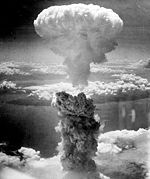
Administrators Vannevar Bush · James Conant · Thomas Farrell · Leslie Groves · Franklin Matthias · Kenneth Nichols · Robert Oppenheimer · William ParsonsScientists Hans Bethe · Niels Bohr · James Chadwick · Arthur Compton · Enrico Fermi · Richard Feynman · Klaus Fuchs · George Kistiakowsky · Ernest Lawrence · William Penney · Emilio G. Segrè · Glenn T. Seaborg · Leó Szilárd · Edward Teller · Richard C. Tolman · Stanislaw Ulam · Harold Urey · Leona Woods · Chien-Shiung WuRelated articles Timeline · History of nuclear weapons · Nuclear weapons and the United States · S-1 Uranium Committee · Chicago Pile-1 · X-10 Graphite Reactor · Y-12 National Security Complex · Operation Alsos · Smyth Report · Project Alberta · 509th Operations Group · Fat Man · Little Boy · Enola Gay · Bockscar · The Great Artiste · Atomic bombings of Hiroshima and Nagasaki (debate) · Atomic Spies · Atomic Energy Act of 1946 · Operation Crossroads · Tube AlloysUnited States in World War II Home Front American music during World War II • United States aircraft production during World War II • Greatest Generation
American WomenWomen Airforce Service Pilots • Women's Army Corps• Woman's Land Army of America • Rosie the RiveterMilitary participation Army (Uniforms) • Army Air Force • Marine Corps • Navy • Service medals (Medal of Honor recipients)
EventsList of Battles • Attack on Pearl Harbor • Normandy landings • Atomic bombings of Hiroshima and NagasakiMinoritiesDiplomatic participation Categories:- 20th-century explosions
- Nuclear weapons of the United States
- World War II strategic bombing of Japan
Wikimedia Foundation. 2010.


